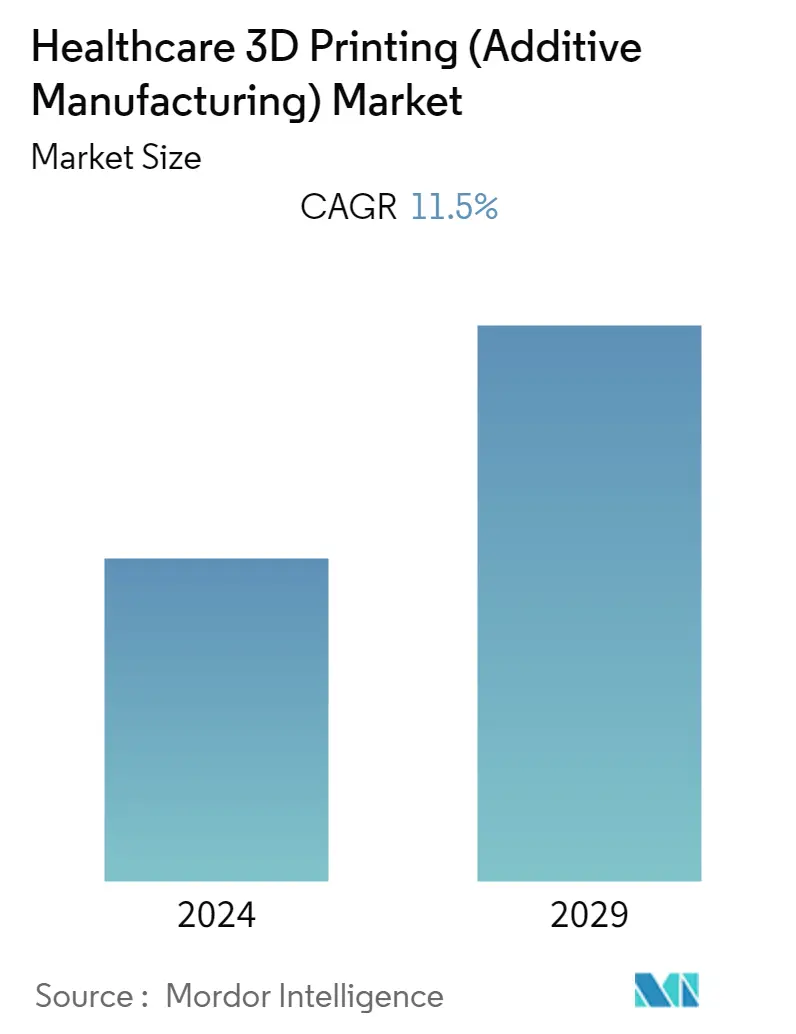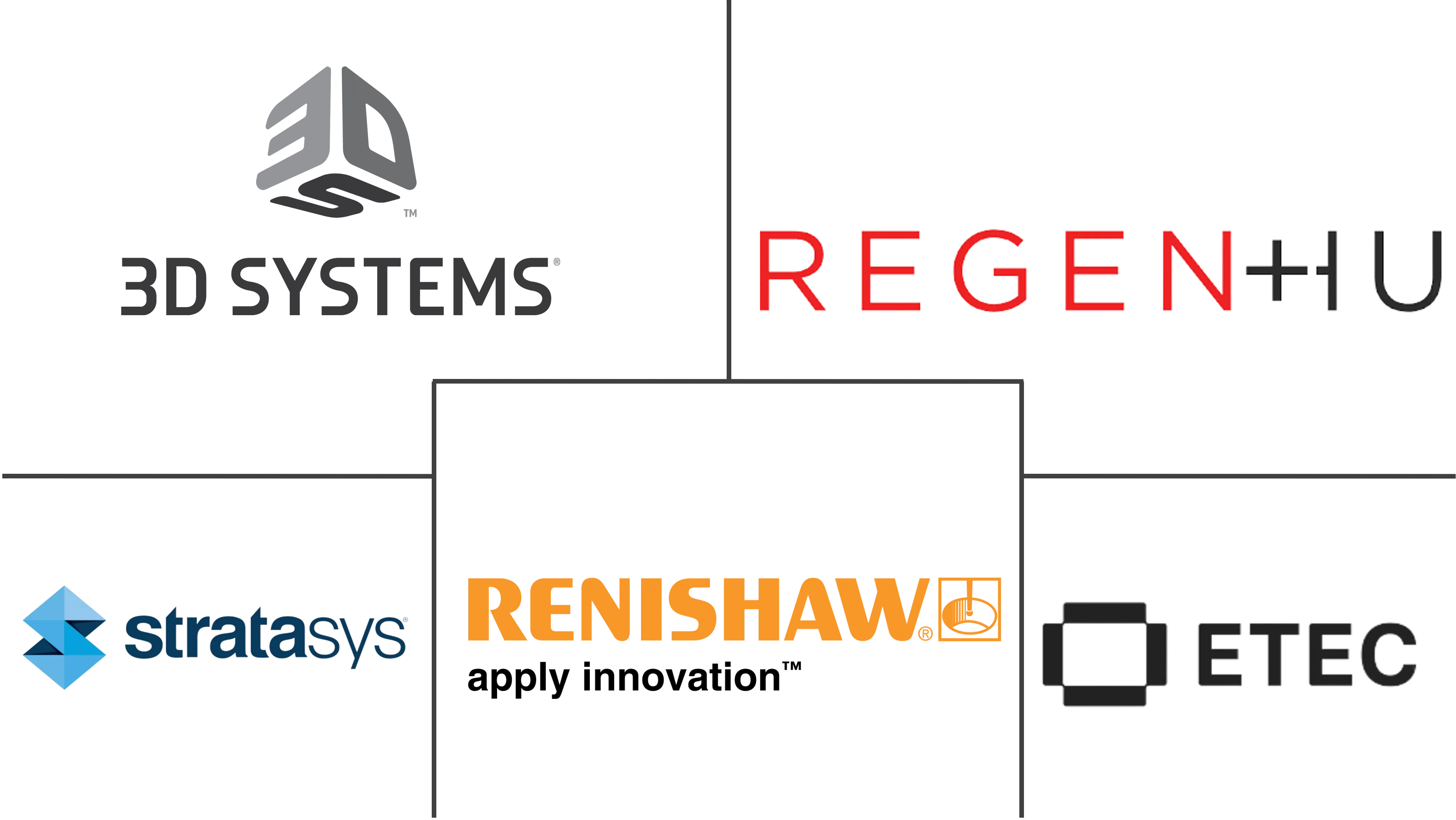Market Size of Healthcare 3D Printing (Additive Manufacturing) Industry

| Study Period | 2019 - 2029 |
| Base Year For Estimation | 2023 |
| CAGR | 11.50 % |
| Fastest Growing Market | Asia-Pacific |
| Largest Market | North America |
| Market Concentration | Medium |
Major Players
*Disclaimer: Major Players sorted in no particular order |
Healthcare 3D Printing Market Analysis
The healthcare 3D printing (additive manufacturing) market is expected to register a CAGR of 11.5% over the forecast period.
COVID-19 significantly impacted the additive manufacturing field in its initial phases. It faced a lack of medical devices during the pandemic. Diverse designs were produced and used in hospitals by patients and health workers, and there has been an increase in the use of 3D-printed devices, such as face shields, masks, valves, and nasopharyngeal swabs. However, as the restrictions were lifted, the demand for the market is likely to increase in the coming years since complete automation and digital workflow are anticipated to be possible with additive manufacturing. In particular, additive manufacturing is likely to replace high-volume, serial production techniques that require both high resolution and high productivity at low cost.
Additive manufacturing, often referred to as 3D printing, has the potential to provide cost-efficient methods to produce highly complex and customized components, single parts, or small batches of products for the healthcare industry. It has numerous applications in the industry. Factors such as rising demand for customized additive manufacturing and demand for 3D printing, driven by increased medical applications, are major driving forces in the market's expansion. For instance, in March 2022, Zoriox Innovation Labs, consisting of a team of surgeons, dentists, mechanical engineers, biomedical engineers, software engineers, graphic designers, prosthetists, and anatomists, created a 360-degree solution for facial reconstruction using 3D printing technology. Moreover, in February 2022, South Carolina-based DeGen Medical Inc., a spinal implant manufacturer focused on Augmented Reality and Patient-Specific Solutions, commercially launched Impulse AM, a 3D-printed porous titanium implant for posterior interbody fusion.
Also, many hearing aids are 3D printed with current innovations and technological advancements, making it one of the important factors to positively drive this market over the forecast period. Further, technological advances are contributing to the market's growth. 3D printing in medicine can provide many benefits, like the customization and personalization of medical products, drugs, and equipment and increased productivity. For instance, in February 2021, Apollo Hospitals and Anatomiz3D Medtech collaborated to design and build hospital 3D printing labs in India that enabled doctors to visualize and print implants for complicated surgical cases. Furthermore, in April 2022, Desktop Health, a healthcare business that creates 3D-printing solutions for personalized medicine, launched the Einstein high-precision series of 3D printers and the Flexcera Smile Ultra+ resin for printing temporary and definitive restorations in the United States. This combination enables dental professionals to quickly generate accurate 3D-printed restorations.
As per the factors mentioned above, healthcare 3D printing (additive manufacturing) is likely to witness growth over the forecast period. However, the cost of additive manufacturing is still high, leading to affordability issues, especially in developing and underdeveloped countries. Also, there is a lack of skilled professionals to operate this machinery. These factors are anticipated to impede the market's growth.
Healthcare 3D Printing Industry Segmentation
As per the scope of the report, 3D printing, or additive manufacturing, is a transformative approach to industrial production that enables the creation of lighter, stronger parts and systems. In healthcare, this approach is used to create implants, instrument parts, and dummy body parts and organs. The Healthcare 3D Printing (Additive Manufacturing) Market is Segmented by Technology (Stereolithography, Deposition Modeling, Electron Beam Melting, Laser Sintering, Jetting Technology, Laminated Object Manufacturing, Other Technologies) by Application (Medical Implants, Prosthetics, Wearable Devices, Tissue Engineering, Other Applications), by Material (Metals and Alloys, Polymers and Other Materials), and by Geography (North America, Europe, Asia-Pacific, South America, Middle East and Africa). The market report also covers the estimated market sizes and trends for 17 countries across major regions globally. The report offers the value (in USD million) for the above segments.
| By Technology | |
| Stereolithography | |
| Deposition Modeling | |
| Electron Beam Melting | |
| Laser Sintering | |
| Jetting Technology | |
| Laminated Object Manufacturing | |
| Other Technologies |
| By Application | |
| Medical Implants | |
| Prosthetics | |
| Wearable Devices | |
| Tissue Engineering | |
| Other Applications |
| By Material | |
| Metals and Alloys | |
| Polymers | |
| Other Materials |
| Geography | ||||||||
| ||||||||
| ||||||||
| ||||||||
| ||||||||
|
Healthcare 3D Printing (Additive Manufacturing) Market Size Summary
The healthcare 3D printing market is poised for significant growth, driven by the increasing demand for customized and cost-efficient manufacturing solutions in the medical sector. Additive manufacturing, commonly known as 3D printing, offers the ability to produce highly complex and personalized medical components, which is becoming increasingly important in various applications such as prosthetics, implants, and surgical planning. The market is experiencing a surge in interest due to its potential to replace traditional production methods with more efficient and cost-effective alternatives. This shift is supported by advancements in technology and materials, particularly polymers, which are widely used in creating medical devices and instruments. The collaboration between healthcare professionals and engineers has led to innovative solutions, such as 3D-printed facial reconstruction and spinal implants, further propelling market expansion.
North America is expected to be a key region for growth in the healthcare 3D printing market, fueled by government support and increased adoption of additive manufacturing in medical applications. The region's focus on research and development, coupled with strategic initiatives like the Additive Manufacturing Forward program, is enhancing the capabilities and availability of 3D printing technologies. The market's fragmented nature, characterized by numerous global and regional players, is fostering competition and innovation through mergers, acquisitions, and collaborations. Despite challenges such as high costs and a shortage of skilled professionals, the market is set to expand, with ongoing advancements in 3D printing technologies and materials playing a crucial role in shaping its future.
Healthcare 3D Printing (Additive Manufacturing) Market Size - Table of Contents
-
1. MARKET DYNAMICS
-
1.1 Market Overview
-
1.2 Market Drivers
-
1.2.1 Increasing Trend in Customized Additive Manufacturing
-
1.2.2 Rising Demand Driven by the Increasing Medical Applications
-
-
1.3 Market Restraints
-
1.3.1 High Costs Associated with Additive Manufacturing
-
1.3.2 Lack of Skilled Professionals
-
-
1.4 Porter's Five Force Analysis
-
1.4.1 Threat of New Entrants
-
1.4.2 Bargaining Power of Buyers/Consumers
-
1.4.3 Bargaining Power of Suppliers
-
1.4.4 Threat of Substitute Products
-
1.4.5 Intensity of Competitive Rivalry
-
-
-
2. MARKET SEGMENTATION (Market Size by Value - USD million)
-
2.1 By Technology
-
2.1.1 Stereolithography
-
2.1.2 Deposition Modeling
-
2.1.3 Electron Beam Melting
-
2.1.4 Laser Sintering
-
2.1.5 Jetting Technology
-
2.1.6 Laminated Object Manufacturing
-
2.1.7 Other Technologies
-
-
2.2 By Application
-
2.2.1 Medical Implants
-
2.2.2 Prosthetics
-
2.2.3 Wearable Devices
-
2.2.4 Tissue Engineering
-
2.2.5 Other Applications
-
-
2.3 By Material
-
2.3.1 Metals and Alloys
-
2.3.2 Polymers
-
2.3.3 Other Materials
-
-
2.4 Geography
-
2.4.1 North America
-
2.4.1.1 United States
-
2.4.1.2 Canada
-
2.4.1.3 Mexico
-
-
2.4.2 Europe
-
2.4.2.1 Germany
-
2.4.2.2 United Kingdom
-
2.4.2.3 France
-
2.4.2.4 Italy
-
2.4.2.5 Spain
-
2.4.2.6 Rest of Europe
-
-
2.4.3 Asia-Pacific
-
2.4.3.1 China
-
2.4.3.2 Japan
-
2.4.3.3 India
-
2.4.3.4 Australia
-
2.4.3.5 South Korea
-
2.4.3.6 Rest of Asia-Pacific
-
-
2.4.4 Middle East and Africa
-
2.4.4.1 GCC
-
2.4.4.2 South Africa
-
2.4.4.3 Rest of Middle East and Africa
-
-
2.4.5 South America
-
2.4.5.1 Brazil
-
2.4.5.2 Argentina
-
2.4.5.3 Rest of South America
-
-
-
Healthcare 3D Printing (Additive Manufacturing) Market Size FAQs
What is the current Healthcare 3D Printing (Additive Manufacturing) Market size?
The Healthcare 3D Printing (Additive Manufacturing) Market is projected to register a CAGR of 11.5% during the forecast period (2024-2029)
Who are the key players in Healthcare 3D Printing (Additive Manufacturing) Market?
3D Systems Inc, regenHU Ltd, Stratasys Ltd, EnvisionTEC and Renishaw PLC are the major companies operating in the Healthcare 3D Printing (Additive Manufacturing) Market.

